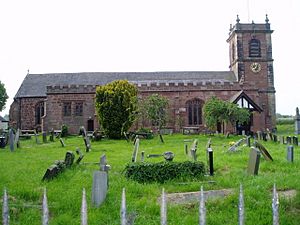St Dunawd's Church facts for kids
Quick facts for kids St Dunawd's Church |
|
|---|---|

St Dunawd's Church in Bangor-on-Dee
|
|
| OS grid reference | SJ 388,454 |
| Location | Bangor-on-Dee, Wrexham County Borough |
| Country | Wales |
| Denomination | Anglican |
| History | |
| Dedication | St Dunawd |
| Architecture | |
| Functional status | Active |
| Heritage designation | Grade II* |
| Architect(s) | Richard Trubshaw, John Douglas |
| Architectural type | Church |
| Completed | 1913 |
| Specifications | |
| Materials | Brick and stone |
| Administration | |
| Parish | Bangor Monachorum, Worthenbury and Marchwiel |
| Deanery | Dee Valley |
| Archdeaconry | Wrexham |
| Diocese | St Asaph |
| Province | Church in Wales |
St Dunawd's Church is a special old church located in the village of Bangor-on-Dee, which is in Wrexham County Borough, Wales. It's considered a very important building by Cadw, which is like the Welsh government's historic buildings agency. They've given it a "Grade II*" listing, meaning it's a building of more than special interest. This church is still actively used today by the Anglican faith. It belongs to the Dee Valley area, within the Wrexham region, and is part of the Diocese of St Asaph.
Contents
History of St Dunawd's Church
Early Beginnings: The Monastery
The church stands on a very old site. Around the year 560, a monastery was built here. A monastery is a place where monks live and worship. This first monastery was started by St Dunawd, who was its first abbot (the leader of the monks).
Sadly, this early monastery was destroyed around 616. An army led by Æthelfrith of Northumbria attacked it. During this attack, 1,200 monks were killed, and only 50 managed to escape. Today, there are no signs left of this ancient monastery.
Building the Stone Church
Much later, around the year 1300, a new church was built on the same spot. This church was made of sandstone. Part of this original stone church, called the chancel, is still standing today. The chancel is the area around the altar in a church.
Restorations and Changes Over Time
The church has been updated many times over the centuries. Between 1723 and 1726, Richard Trubshaw worked to restore it. This work included fixing up the bell tower. In 1832, the north aisle was changed. An aisle is a walkway in a church.
A famous architect named John Douglas was married in this church in 1860. He later worked on the church himself. In 1868, he led a big restoration project. This included making the south aisle bigger to create a baptistery, which is where baptisms take place. He also restored the chancel.
Douglas did more work in 1877. He added a half-timbered porch to the church's entrance. A porch is a covered area at the front. The last major changes happened in 1913. A new vestry was built, and the church organ was moved to a different spot. A vestry is a room in a church used for changing robes or storing things.
Church Architecture and Features
Tower and Windows
The church's tower is built using both brick and stone. It has special round-headed openings where the bells are. The top of the tower has urn-like finials, which are decorative parts.
The chancel has a large east window with five sections. This window dates all the way back to the 14th century. There's also a two-section window on the south wall of the chancel. The north aisle, which was changed in 1832, has windows in a style called Perpendicular Gothic.
Inside the Church: Furniture and Fittings
Inside the church, you'll find many interesting features. The stalls (seats for the clergy) and rails were added in 1868. The pews (seats for the congregation) and the pulpit were put in during 1877. The pulpit is a raised platform where sermons are given. It is beautifully carved with patterns that look like tracery and sunflowers.
The organ screen, designed by John Douglas, was moved in 1913. The cover for the font was designed by Evelyn Wybergh. The font is a basin used for baptisms. An old reredos from 1725 is now at the west end of the church. A reredos is a decorative screen behind the altar. There's also a brass lectern, which is a stand for reading. It remembers three brothers who died in the First World War.
The Church Bells
St Dunawd's Church has a ring of six bells. Four of these bells were made in 1727 by Abraham Rudhall II. Another bell was made in 1811 by John Rudhall. The sixth bell was made in 1865 by Mears and Stainbank.
Churchyard and War Graves
The churchyard is the area around the church. It contains six war graves. These graves are registered by the Commonwealth War Graves Commission. Five of the graves are from World War I, and they include three brothers from the Ormrod family. There is also one grave from World War II for an officer from the King's Shropshire Light Infantry.
See also

